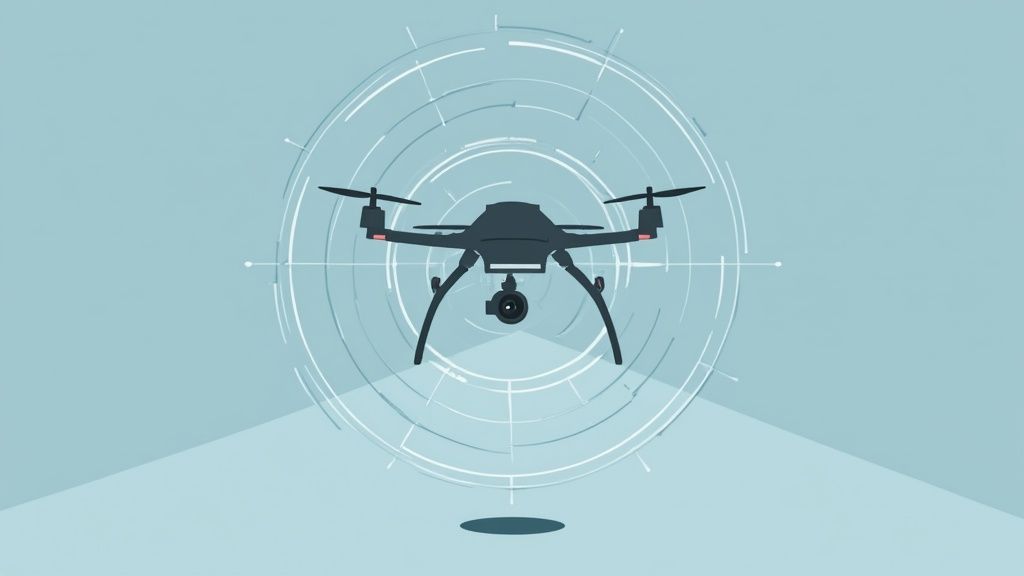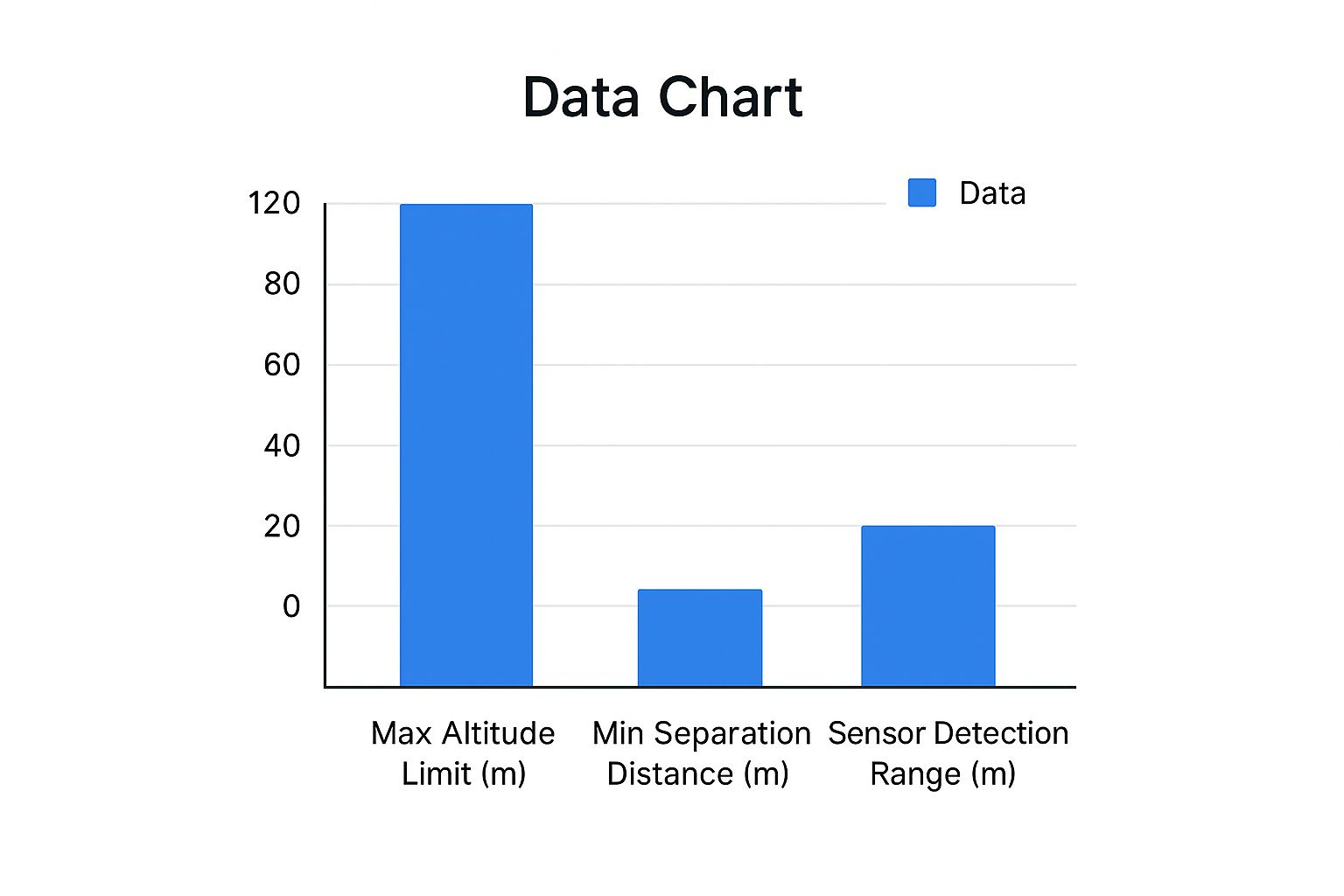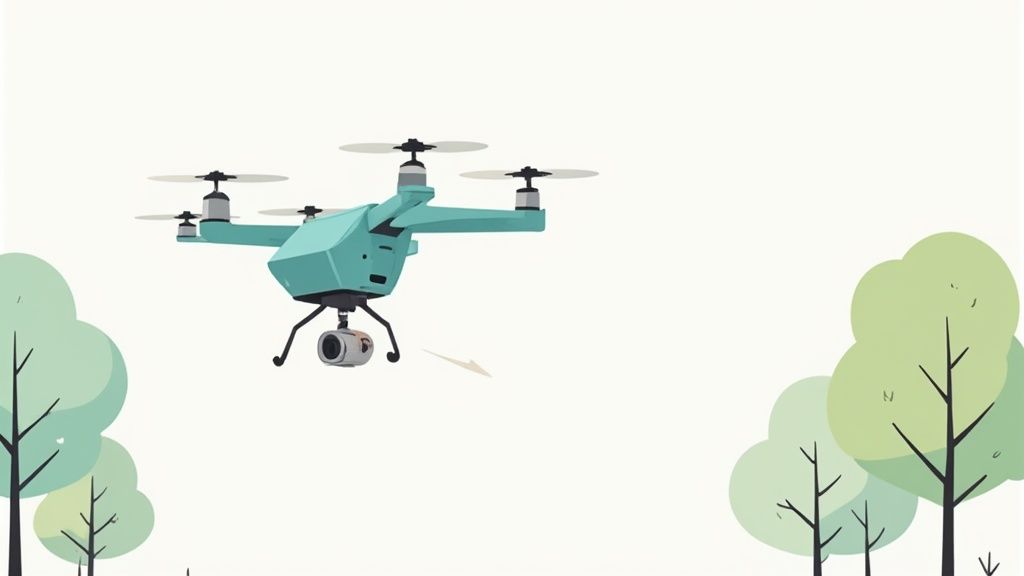Drone Collision Avoidance: Enhancing Flight Safety Today
- A.E. Williams

- May 20
- 12 min read
Why Drone Collision Avoidance Matters Today
Our skies are getting busier, and that poses a real challenge to keeping everyone safe. The growing popularity of drones, for both fun and work, adds a whole new layer to air traffic control. Traditional systems aren't designed to handle the sheer number and maneuverability of these unmanned aircraft. This highlights the urgent need for reliable drone collision avoidance solutions.
This demand comes from a worrying rise in near misses. From 2014 to 2024, reports of drone-related near-midair collisions near major U.S. airports have climbed significantly. In 2024 alone, drones accounted for 64% of all near-midair collision reports around the 30 largest U.S. airports. This is a big jump from the approximately 50% they represented in the previous decade. This increase mirrors the growth in registered drones, which topped one million by the end of 2024. The Federal Aviation Administration (FAA) receives around 100 safety reports involving drones every month, emphasizing growing safety concerns. For more details, check out this article: Risk Of A Drone Colliding With Commercial Aircraft Is Increasing.
The Stakes Are High
The potential fallout from drone collisions is serious. A crash between a drone and a manned aircraft, especially a commercial airliner, could be devastating. Even near misses can cause major disruptions, forcing pilots into evasive maneuvers and emergency landings. In 2024, a drone came within 300 feet of a cockpit near San Francisco. In another incident near Miami, a drone was just 4,000 feet from an aircraft. For helpful safety tips, see: Drone Safety Tips: How to Avoid Accidents and Hazards.
Drone Collision Avoidance: More Than Just a Feature
Drone collision avoidance isn't a bonus anymore—it's a must-have. It's the foundation of a safe and sustainable drone industry. Effective collision avoidance systems are vital for protecting both manned and unmanned aircraft. They're also key to ensuring public safety and allowing the drone industry to continue to thrive. Investing in and using reliable drone collision avoidance technology is essential for the future of aviation.
The Need for a Multi-Layered Approach
Tackling the issue of drone collision avoidance demands a multifaceted strategy. This includes technological advancements, strong regulations, and responsible drone operation. This combined approach will help ensure drones can operate safely and efficiently in our increasingly complex airspace.

Breaking Down Collision Avoidance Technologies
Drone collision avoidance systems have evolved significantly. They're no longer simple obstacle detectors but intricate systems ensuring safe flight. Let's explore how these sensors work together to protect a drone.
Understanding the Sensor Ecosystem
Visual cameras, much like our eyes, give drones a basic understanding of their surroundings. These cameras capture images, which are then processed to identify potential obstacles.
LiDAR (Light Detection and Ranging) creates detailed 3D maps of the environment. This allows the drone to determine an obstacle's distance, size, and shape, crucial for navigating complex terrains and avoiding collisions in cluttered environments.
Infrared sensors allow drones to "see" heat signatures, even in darkness. This is essential for night operations like search and rescue or security patrols. For close-range detection, ultrasonic sensors emit high-frequency sound waves and measure the time it takes for them to bounce back. This effectively measures the distance to nearby objects. Advancements in aerial filming also influence collision avoidance technologies. Check out this drone video to see the level of image quality modern drones can achieve.
From Sensor Data to Flight Decisions
Raw sensor data is useless without processing. Advanced algorithms transform this data into navigation decisions. These algorithms act as the drone's "brain," constantly analyzing sensor inputs and calculating the optimal flight path.
For example, if a drone detects an approaching bird, the algorithms assess the bird’s trajectory and speed. The drone then adjusts its flight path, perhaps by changing altitude or maneuvering around the bird, all while maintaining its mission. This rapid processing is essential for effective drone collision avoidance.
The Importance of Redundancy
Multi-sensor redundancy is key for reliable collision avoidance. Relying on a single sensor is risky. Visual cameras struggle in low light, while LiDAR can be affected by heavy fog.
Combining sensor types compensates for individual weaknesses, creating a robust safety net. If one sensor fails, others ensure safe operation. This multi-layered approach is crucial for effective drone collision avoidance.
To further illustrate the different sensor technologies used in drone collision avoidance systems, let’s look at a comparison table:
The following table provides a comparison of the primary sensor technologies used in modern drone collision avoidance systems.
Sensor Type | Range | Weather Performance | Size/Weight | Power Consumption | Cost Range |
|---|---|---|---|---|---|
Visual Camera | Varies, generally up to several hundred meters | Affected by low light, fog, and heavy rain | Small and lightweight | Low | Relatively inexpensive |
LiDAR | Up to several kilometers | Affected by heavy fog and snow | Can be bulky and heavy, but becoming more compact | Moderate | Moderate to high |
Infrared | Varies, depending on the heat signature of the object | Can be affected by extreme temperatures | Small and lightweight | Low to moderate | Moderate |
Ultrasonic | Short range, typically up to a few meters | Generally unaffected by weather | Small and lightweight | Low | Relatively inexpensive |
As the table shows, each sensor type has its own strengths and weaknesses. Visual cameras are cost-effective and lightweight but struggle in poor lighting. LiDAR provides excellent range and 3D mapping but can be more expensive and heavier. Infrared is useful in darkness, while ultrasonic excels at close-range detection. The best collision avoidance systems leverage the strengths of multiple sensors for comprehensive coverage.
Leading Collision Avoidance Systems Compared
Drone collision avoidance technology is crucial for safe drone operations. But not all systems offer the same level of protection. This comparison of leading systems highlights their strengths and weaknesses, focusing on how DJI, Skydio, and Autel approach obstacle detection and avoidance. For a broader overview, check out this article: Drone Collision Avoidance: Top Systems for Safer Flights.
DJI's Advanced Pilot Assistance System (APAS)
DJI's APAS uses visual sensors and advanced algorithms to detect and navigate around obstacles. The system creates a 3D map of the environment, allowing the drone to autonomously plan a safe path. APAS performs well in structured environments with clearly defined obstacles. However, challenging lighting or complex, rapidly changing environments can impact its performance.
Strengths: Reliable in controlled settings, user-friendly interface, widely available on DJI drones.
Weaknesses: Can struggle in low light or complex natural environments.
Skydio's Autonomous Navigation System
Skydio uses multiple cameras and sophisticated AI to provide 360-degree obstacle avoidance. This system allows for complex maneuvers in challenging environments, even navigating dense forests. Skydio drones build a comprehensive understanding of their surroundings, enabling intelligent, real-time flight decisions. Obstacle handling is key for collision avoidance. For more details, see this article on drone obstacle avoidance.
Strengths: Exceptional autonomous navigation, excels in complex terrains, high level of obstacle awareness.
Weaknesses: Higher price point compared to DJI systems.
Autel's Obstacle Avoidance Technology
Autel uses binocular vision sensors and advanced algorithms for precise obstacle detection. Their system is known for its accuracy and reliability across various environments. Autel balances performance and affordability, making it a strong alternative to DJI and Skydio. However, its effectiveness can be reduced in conditions like heavy fog or snow.
Strengths: Accurate obstacle detection, performs well in diverse environments, competitive pricing.
Weaknesses: Performance can be impacted by adverse weather.
Comparing System Performance
This table summarizes the key features and capabilities of these leading drone collision avoidance systems:
Feature | DJI (APAS) | Skydio | Autel |
|---|---|---|---|
Sensor Type | Visual | Multiple Cameras | Binocular Vision |
Obstacle Detection | Good | Excellent | Excellent |
Autonomous Navigation | Good | Excellent | Good |
Environmental Adaptability | Moderate | High | Moderate |
Cost | Moderate | High | Moderate |

The drone collision avoidance technology market is growing rapidly as the industry focuses on mitigating safety risks. Valued at $1.5 billion in 2022, it's projected to reach $4.7 billion by 2030, growing at 18.2% annually. Innovations like real-time obstacle detection sensors and geofencing systems are driving this growth. Learn more about drone safety and market projections.
Choosing the right system depends on your needs and budget. DJI's APAS is a good option for general use in controlled environments. For demanding applications in complex terrains, Skydio's autonomous navigation offers superior performance. Autel provides a balance of performance and affordability. As drone technology advances, collision avoidance systems will continue to evolve, improving safety and reliability.
Anatomy of Drone-Aircraft Near-Miss Incidents
Behind every near-miss statistic lies a valuable opportunity to learn and enhance drone safety. This section delves into the factors contributing to these dangerous drone-aircraft encounters. We'll explore real-world incidents, ranging from commercial airliners narrowly avoiding drones at high altitudes to helicopters being forced into evasive maneuvers.
Understanding the Risks
One of the primary concerns revolves around the proximity of drone incidents to airports. Research indicates a significant number of these encounters occur alarmingly close to manned aircraft, creating substantial collision risks. The infographic below visualizes the critical relationship between maximum altitude limits for drones, the minimum safe separation distance from aircraft, and the typical range of drone sensor detection.

This infographic clearly illustrates that while sensor detection range offers a safety buffer, it's essential for drone operators to adhere to altitude limits and maintain safe distances from other aircraft. Even with advanced sensors, responsible operation is paramount.
Temporal and Geographic Trends
Analyzing when and where these incidents occur reveals important patterns. For example, in 2025, multirotor drones were involved in over 70% of reported drone-aircraft close encounters. More than 60% of these encounters took place within 200 feet of airports, with over 20% occurring within 50 feet of manned aircraft. Single-engine propeller planes were involved in 125 incidents, followed by multi-engine jets with 116 cases, and helicopters with 38 cases.
Over two-thirds of encounters happened between 10 a.m. and 6 p.m., peaking between 2 p.m. and 6 p.m. This data underscores the need for robust drone collision avoidance systems, especially around airports. You can find more detailed statistics here.
To further illustrate these statistics, let's look at a breakdown of the data:
Drone-Aircraft Near-Miss Incident Statistics: Key statistics on drone-aircraft encounters showing aircraft types involved, proximity distances, and temporal patterns
Parameter | Frequency | Percentage | Risk Level |
|---|---|---|---|
Multirotor Drone Involvement | N/A | 70% | High |
Incidents within 200ft of Airports | N/A | 60% | High |
Incidents within 50ft of Aircraft | N/A | 20% | Critical |
Single-Engine Propeller Plane | 125 | N/A | High |
Multi-Engine Jet | 116 | N/A | High |
Helicopter | 38 | N/A | High |
Encounters (10 a.m. - 6 p.m.) | N/A | 66%+ | Medium |
Peak Encounters (2 p.m. - 6 p.m.) | N/A | N/A | High |
This table provides a clear overview of the frequency and associated risk levels of drone-aircraft near misses, highlighting the importance of continued efforts in improving drone safety.
The Human Element
Understanding the psychology of drone operators is also crucial for mitigating risk. Many incidents stem from misjudging distances, overestimating abilities, or simply not recognizing the potential consequences of irresponsible drone operation. This emphasizes the importance of education and training for drone pilots. Clear guidelines and comprehensive training programs are vital for promoting responsible drone use and preventing future incidents.
Technology as a Safety Net
Drone collision avoidance technology is essential for mitigating risk, especially in situations where human judgment fails. These systems act as a crucial safety net, providing an extra layer of protection in complex airspace.
Automatic Emergency Braking: This feature can automatically stop a drone to prevent a collision.
Obstacle Avoidance: This helps drones navigate around obstacles, reducing the risk of collisions.
Further, the integration of real-time data feeds from air traffic control (FAA) can enhance the effectiveness of these systems. By incorporating data about the location and movement of other aircraft, collision avoidance technology can proactively adjust flight paths and prevent potential conflicts. These advancements represent a significant step towards safer drone integration into our airspace.
Navigating the Regulatory Landscape
Drone collision avoidance regulations are constantly evolving, creating exciting opportunities and challenges. This section offers a practical overview of these complex rules and their impact on collision avoidance requirements. We'll examine how organizations like the FAA and EASA work to maintain safe skies through technology mandates.
Remote ID and Collision Avoidance
Remote ID, a system for identifying drones mid-flight, is crucial for collision avoidance. Imagine it as a digital license plate, broadcasting information about the drone and its operator. This allows authorities to track drones and ensure legal operation. Crucially, Remote ID data can be integrated into collision avoidance systems.
This integration enables drones to detect each other electronically, even beyond visual range, significantly improving overall airspace safety. This electronic visibility adds another layer of security, preventing potential collisions and promoting responsible drone operation.
Operational Limitations and Sensitive Areas
Regulations often restrict drone flights near sensitive areas like airports, government buildings, and critical infrastructure. These operational limitations are essential for safety and security. Collision avoidance systems play a vital role in enforcing these restrictions.
Geofencing, a virtual boundary using GPS, can prevent drones from entering restricted airspace. This automated safety feature is particularly important near sensitive locations. This technology acts as an invisible barrier, preventing unintentional entry into restricted zones and enhancing overall security measures.
You might be interested in: Navigating the Future: DJI Drones and the Potential US Ban.
Certification and Drone Categories
Different drone categories have different certification requirements. Commercial drones used for deliveries or inspections often require more stringent certification than recreational drones. These certifications often mandate specific collision avoidance system standards.
This ensures drones used for complex tasks have robust safety features. These rigorous standards prioritize safety and reliability in commercial operations, reducing the risk of accidents and promoting professional drone use.
UTM Systems and Compliance Timelines
UTM (Unmanned Traffic Management) systems are being developed to manage drone traffic in low-altitude airspace. Think of it as air traffic control specifically designed for drones. Collision avoidance technology is fundamental to UTM systems.
By integrating real-time location data and flight plans, UTM systems can help drones avoid each other, further enhancing airspace safety. Compliance timelines for these evolving regulations are critical for operators and manufacturers. Keeping up-to-date and adapting to new rules ensures continued safe and legal drone operations.
Strategies for Staying Ahead
The drone regulatory environment is constantly changing. Operators and manufacturers need to be proactive. Attending industry conferences, following regulatory updates, and engaging with industry organizations keeps stakeholders informed.
Anticipating regulatory changes allows businesses to adapt and maintain efficiency while meeting the latest safety standards. This proactive approach is essential for navigating the dynamic drone regulatory landscape and ensuring long-term success in the industry.
Next-Generation Collision Avoidance Innovations

The world of drone collision avoidance is constantly evolving. New technologies are emerging that promise to make drone flights safer than ever before. These advancements pave the way for more complex and autonomous drone operations.
Miniaturized Radar Systems
One promising development is the miniaturization of radar systems. These smaller, lighter radar units are becoming more sophisticated. They offer improved detection range and accuracy, allowing drones to detect obstacles, including other aircraft, at greater distances. This provides more time to react and avoid collisions. Some advanced systems can even detect small objects, like birds, from hundreds of meters away.
AI-Powered Computer Vision
Artificial intelligence (AI) plays a significant role in enhancing drone collision avoidance. AI-powered computer vision systems are becoming incredibly good at recognizing objects. These systems can differentiate between a bird, a building, or another drone. This allows the drone to make informed decisions about how to react. These systems are constantly learning and improving, becoming more accurate and reliable with each flight. For more information, check out this article: Air Aware by Aloft Technologies: A New Era in Drone Safety and Situational Awareness.
Cooperative Avoidance Protocols
Another important advancement is the development of cooperative avoidance protocols. These protocols enable drones to communicate with each other. They share crucial information about their location, speed, and planned flight path. This drone-to-drone communication allows for coordinated maneuvers. Drones can then avoid each other automatically, much like cars yielding at an intersection. This technology is particularly important for managing drone traffic in busy airspace.
5G and Networked Avoidance
The rollout of 5G connectivity is transforming drone collision avoidance. 5G's high bandwidth and low latency enable networked avoidance systems. Drones can share data not just with each other, but also with a central control system. This creates a comprehensive picture of the airspace and allows for more efficient and proactive collision avoidance strategies.
Predictive Avoidance with Machine Learning
Machine learning algorithms are also making a significant impact. By training these algorithms on large datasets of flight data, drones can learn to predict potential conflicts. This predictive avoidance allows drones to anticipate potential hazards. They can take corrective action before a near-miss occurs. This dramatically improves flight safety, especially in dynamic environments.
The Future of Drone Collision Avoidance
These technologies represent a significant step forward in drone collision avoidance. They address many limitations of current systems and open up new possibilities for drone operations. As these innovations mature, they will play a key role in enabling safer and more efficient drone flights. This will pave the way for expanded drone use in various sectors, from commercial deliveries to search and rescue operations.
Implementing Effective Collision Avoidance Strategies
Effective drone collision avoidance isn't simply about owning the newest technology; it's about utilizing it strategically. This involves a multi-faceted approach that integrates pre-flight planning, appropriate technology selection, thorough training, and consistent maintenance. This section offers practical advice for drone operators and fleet managers to optimize their collision avoidance systems.
Pre-Flight Assessment and Environmental Factors
Before each flight, a comprehensive risk assessment is essential. This goes beyond simply checking the forecast. Consider the specific flight environment. Are there obstacles like power lines, tall buildings, or other potential hazards? What are the wind conditions and visibility? This information will inform your drone selection and the necessary collision avoidance settings.
Terrain Analysis: Identify potential obstacles using resources like Google Maps and on-site surveys.
Weather Check: Remember that strong winds, fog, or rain can significantly impact sensor performance.
Contingency Planning: Always have backup plans in place in case of system malfunctions.
For example, operating near skyscrapers might require a drone equipped with 360-degree obstacle avoidance. Flying in a densely wooded area might necessitate slower speeds and increased sensor sensitivity.
Technology Selection and Operational Profile
Selecting the correct collision avoidance system depends heavily on your drone's intended use. A system designed for infrastructure inspections might not be suitable for package delivery.
Sensor Types: Consider the strengths and weaknesses of different sensor technologies. Visual cameras generally perform well in good lighting, while LiDAR excels in low-visibility conditions.
Range and Accuracy: Choose a system that provides adequate range and accuracy for your specific operations.
Integration with Existing Systems: Ensure compatibility with your current drone platform and flight control software.
Integrating Collision Avoidance Into Safety Management
Collision avoidance isn't a standalone feature; it's an integral component of a comprehensive safety management system. This includes:
Standard Operating Procedures (SOPs): Develop clear procedures for pre-flight checks, in-flight monitoring, and emergency responses.
Training: Provide thorough training to pilots on how to use the collision avoidance system and react appropriately to system alerts.
Maintenance: Regularly inspect and calibrate sensors to ensure they are functioning optimally.
For instance, SOPs should clearly define when to activate various avoidance modes and how to respond to system alerts. Consistent training reinforces pilot knowledge and ensures they can effectively handle unexpected events.
Training Pilots and Maintaining Systems
Pilots must understand the system's capabilities and limitations. Training should cover:
System Functionality: How the sensors operate, their limitations, and how to interpret the system’s alerts.
Emergency Procedures: The steps to take if the system malfunctions or a near-miss occurs.
Documentation: The importance of maintaining accurate records of incidents and near misses.
Regular maintenance is also crucial for ensuring the reliability of the sensors.
Calibration: Regularly calibrate sensors to maintain their accuracy.
Cleaning: Keep sensors clean and free from any debris that could obstruct their operation.
Firmware Updates: Install the latest firmware updates to benefit from performance enhancements and bug fixes.
Troubleshooting and Practical Workflows
Even the most advanced systems can encounter issues. Experienced operators often develop practical workflows to address these limitations:
Environmental Challenges: Understand how varying weather conditions and environments affect sensor performance.
System Limitations: Be aware of the system’s inherent limitations, such as detection range and potential blind spots.
Troubleshooting Techniques: Learn how to troubleshoot common issues and know when to seek technical support.
By integrating cutting-edge technology with proactive strategies, drone operators can significantly enhance safety. These practical measures not only minimize the risk of collisions but also improve operational efficiency, ensuring drones can execute their tasks safely and reliably. Ready to take your drone operations to the next level? Visit JAB Drone for expert advice, product reviews, and the latest news in the drone industry.




Comments